WP2: Experimental Testing
Vertical Sloshing in Flexible Structures: Experimental Testing and Achievements
Methods Developed
Novel test rigs and measurement methodologies developed.
Main findings:
- SDOF transient rigs – maximum R1 damping varies with initial amplitude, increasing rapidly up to 4g and then slowly decreasing
- SDOF harmonic rigs – energy dissipation is frequency dependent, possible to excite both R1 and R2 regions either separately or simultaneously
- Scaling of damping mechanism depends upon tank dimensions, Froude number and filling level
- Mechanisms explained in terms of kinetics of bulk fluid motion relative to tank and phase changes between forcing and fluid response motions
Experimental Testing
Tests performed on 1DOF, beam-like and scaled wing models to explore the physics of vertical sloshing in flexible structures subjected to transient and harmonic excitation of differing amplitudes and frequencies. Measured data provides validation cases for numerical modelling approaches developed in SLOWD.
Main objectives:
- Provide data to validate numerical fluid-structure-interaction models (high and low fidelity)
- Provide experimental demonstration on the use of vertical sloshing to enhance the damping in structural response
- Provide experimental demonstration of dependence of effective damping on sloshing system parameters - amplitude, frequency, Froude number, fluid density, container dimensions.
Achievements
A number of different test rigs were developed to enable exploration of various aspects of vertical sloshing motion and resulting damping characteristics.
Main findings:
1. One DOF transient response rigs:
Three regions of fluid response: turbulent (R1) / lateral sloshing mode (R2) / little liquid motion (R3)
Much higher damping achieved from the first two phases
Damping level depends upon fill level (50% max), maximum acceleration and fluid density
2. One DOF Harmonic rigs
Damping level depends upon frequency and amplitude level
Cross-over between turbulent and lateral mode zones
Hysteretic cycle for force vs displacement amplitude
Similar behaviour for transient and harmonic Energy Loss vs Froude number plots
3. Scaled (3m long) equivalent wing model
Provides more realistic 3D multi-DOF test case to scale with full scale wing tests.
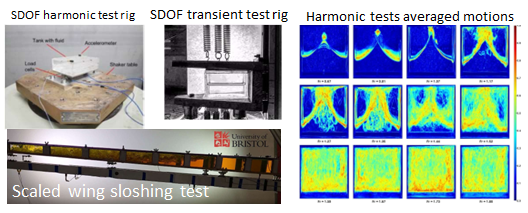
Related references:
Saltari, F., Pizzoli, M., Coppotelli, G., et al. (2022). "Experimental characterisation of sloshing tank dissipative behaviour in vertical harmonic excitation. Journal of fluids and structures", 109, 103478. https://doi.org/10.1016/j.jfluidstructs.2021.103478
Constantin et al. (2022). "Effect of Fuel Sloshing on the Damping of a Scaled Wing Model – Experimental Testing and Numerical Simulations". Appl. Sci. 12(15), 7860. https://doi.org/10.3390/app12157860
Constantin, L., De Courcy, J., Titurus, B., et al. (2021). "Analysis of damping from vertical sloshing in a sdof system". Mechanical Systems and Signal Processing, 152, 107452. https://doi.org/10.1016/j.ymssp.2020.107452
Martinez-Carrascal, J. and Gonzalez-Gutierrez, L. M. (2021). "Experimental study of the liquid damping effects on a sdof vertical sloshing tank". Journal of Fluids and Structures, 100, 103172. https://doi.org/10.1016/j.jfluidstructs.2020.103172
WP3: Fluid dynamics
Advancing Aircraft Fuel Slosh Modeling
Methods Developed
Methods have been developed for the identification of linear and nonlinear reduced-order models for sloshing.
Main findings:
- Two novel SPH modelling codes SPH-Flow and AQUAGPUSPH were employed. The models included single and multi-phase, accounted for compressibility effects and turbulence as well as surface tension.
- The AQUAGPUSPH code is GPU based and employs also surface tension models to predict Rayleigh-Taylor instability.
- The SPH-Flow code is an industrial strength 3D parallel tool which accounts for multi-physics such as compressibility effects, turbulence via a novel Large Eddy Simulati SM1) model. It offers high precision accuracy.
- The Elemental VOF code assumed an incompressible liquid but includes gas compressibility under impact as well as surface tension and LES based turbulence modelling all in 3D.
Experimental Testing
WP3 is focused on the development, assessment and comparison of a range of full order computational fluid dynamics (CFD) models to model aircraft fuel slosh. Particular emphasis was on the quantitative description of the damping effects due the interaction between fuel and wing structures. The physics considered include momentum conservation, viscous effects (including turbulence) and surface tension.
The main objectives were:
- Development of flow physics metrics to quantify fluid damping. A range of metrics were developed with which to quantify slosh induced damping
- To this end several state-of-the-art multi-phase codes were extended, refined and applied to compute slosh induced damping. These comprised the open-source in-house developed SPH code (AQUAGPUSPH) based on a GPU technology. The industrial code SPH-Flow which is capable of using simulating slosh via 1E7 – 1E8 particles. Finally, the Elemental CFD volume-of-fluid (VOF) mesh based code.
- A range of test cases, which include SLOWD experimental tests, were simulated. This included a wide range of fluid densities and viscosities.
- Finally, the resulting SPH and VOF codes were compared to each other as well as experimental data. This enabled assessing the computational cost and level of accuracies attainable in modeling slosh damping.
Achievements
An extensive range of CFD algorithm and code developments were successfully completed followed by application and validation. This resulted in 20 peer reviewed publications and 18 articles in conference proceedings.
Following several key technical achievements:
- Two novel Smoothed Particle Method (SPH) models were used as numerical tools for the simulation of slosh induced loads and damping. This was complemented with the VOF mesh based Elemental code.
- A range of 2D and 3D slosh cases were successfully modelled spanning a wide range of Reynolds numbers and excitation Froude numbers. This is the first project to rigorously document via publications the performance of the different modelling techniques in doing this. Overall a high degree of success was achieved in accuracy.
- The successful prediction of slosh induced damping over a range of fluid and excitation conditions allowed the development of non-dimensional scaling laws to characterize slosh induced damping which can be used for aircraft design. SLOWD is again the first to achieve and document this
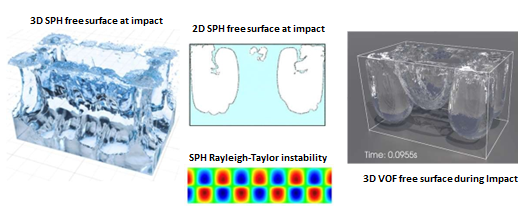
Related references:
Michel, J., Durante, D., Colagrossi, A., & Marrone, S. (2022). "Energy dissipation in violent three-dimensional sloshing flows induced by high-frequency vertical accelerations". Physics of Fluids, 34(10), 102114. https://doi.org/10.1063/5.0114635
MD Wright, F Gambioli, and AG Malan (2021). "Cfd based non-dimensional characterization of energy dissipation due to verticle slosh". Applied Sciences, 11(21). https://doi.org/10.3390/app112110401
WP4: Structural Dynamics
Advancing Structural Dynamics Modeling
Methods Developed
The methods developed to support the structural dynamics modelling include full scale implementation and specialised calibrated versions of mathematical models.
Main findings:
- Implementation of 2D geometrically nonlinear finite segment beam model in support of large deformation analysis and its impact on: i) inertial loading during sloshing, ii) nonlinear parasitic damping sources.
- Full 3D Nastran MiniWoT model updating (WP2) to enable reliable high-fidelity FSI simulations through comprehensive analysis of secondary and nonlinear sources associated with joints and boundary conditions.
- Development of an advanced calibrated FEA-ROM model for exploratory and performance-focused FSI analysis of wings under gust and turbulence loading conditions.
Experimental Testing
The main aim of this WP was to support structural dynamics modelling and analysis part of the work completed in WP2 and other FSI-focused WPs. The resulting structural models included Nastran FEA, modal and dedicated geometrically nonlinear beam formulations. They were used to support the experiment design, dry and FSI analysis and experimental data interpretation.
Main objectives:
- Development of geometrically nonlinear 3D reference model to enable reliable fluid-structure coupling of the primary MiniWoT experiment in WP2.
- Development of geometrically exact 2D beam model to investigate impact of large displacements and finite rotations on the input (motion) spectra during FSI under comparable sloshing conditions.
- Model analysis in “wet” wing configuration to interpret the FSI effects observed in WP2 and to motivate the development ROMs in WP5 for extended aeroelastic analysis
Achievements
Developed understanding, appreciation and enabling modelling support for high and low fidelity FSI analyses.
Main findings:
- MiniWoT FE model and experimental data available to all SLOWD partners.
- Physical insights and model calibration regarding large deflection nonlinear damping in dry structure.
- Proposed ad hoc models to capture nonlinear effects due to aerodynamic and dry damping.
- Described amplitude and frequency characteristics arising under geometric nonlinearity.
- Interpreting the physics of FSI coupling and support of SPH/ROM model development.
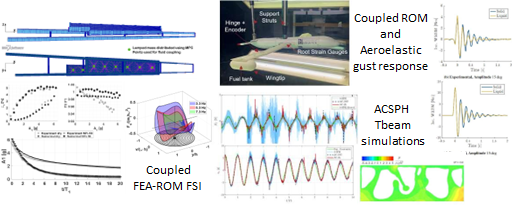
Related references:
Constantin L, De Courcy JJ, Titurus B, Rendall T, Cooper JE, Gambioli F, "Effect of Fuel Sloshing on the Damping of a Scaled Wing Model-Experimental Testing and Numerical Simulations". Applied Sciences, 12(15) 7860, 2022. https://doi.org/10.3390/app12157860
Constantin L, De Courcy J, Titurus B, Rendall TCS, Cooper JE, "Fuel sloshing-induced effects on the dynamic response of a scaled research wing demonstrator". Aerospace Science and Technology 140 108450 2023. https://doi.org/10.1016/j.ast.2023.108450
Healy, Fintan, Joe J. De Courcy, Huaiyuan Gu, Djamel Rezgui, and Jonathan E. Cooper. Experimental Effect of Liquid Sloshing on the Dynamic Behaviour of Flared Folding Wingtips. In AIAA SCITECH 2023 Forum, p. 2569. 2023. https://doi.org/10.2514/6.2023-2569
De Courcy J, Rendall T, Titurus B, Constantin L, Cooper JE, Artificial compressibility for smoothed particle hydrodynamics using pressure smoothing, 17th SPHERIC International Workshop, 27-29 June 2023, Rhodes, Greece
WP5: Fluid/Structure Coupling
Advancing Sloshing Simulation
Methods Developed
A coupling methodology suited to both SPH and VoF has been designed and implemented in a new software framework. This provides the capability to simulate complex sloshing phenomena using MSC Nastran for the structural component whilst selecting the best fluid solver for the problem type.
Main findings:
- FSI framework based on MUI coupling library, including a custom proxy application to enable the use of high-performance coupling.
- A fixed iteration coupling method implemented with the Elemental Volume of Fluid solver.
- A sequential staggered scheme implemented
- with the SPH Flow solver.
- Definition of coupled model of scaled wing experiment using both fluid approaches.
- An open source framework named ParaSiF
Experimental Testing
Definition and creation of new coupled workflows to enable high-fidelity simulation of complex sloshing phenomena that current software is unable to tackle.
Multiple fluid methods are considered alongside structural modelling driven by MSC Nastran, while an open source equivalent suitable for sandbox testing and public dissemination is developed at the same time. All approaches utilize an open source general purpose code coupling library called the Multiscale Universal Interface (MUI).
Main objectives:
- Define and develop coupled algorithms to enable simulation of complex sloshing using the Volume of Fluid(VoF) and Smoothed Particle Hydrodynamics (SPH) CFD methods.
- Create a new software implementation that couples both SPH and VoF solvers to MSC Nastran to create a Fluid Structure Interaction (FSI) framework.
- Implement and publicly release an open source equivalent using non commercial software.
- Define and simulate high-fidelity coupled models that draw in from CFD and structural modelling efforts in WP3 and WP4 respectively and validate experimental work from WP2.
- Couple a structural control model developed in WP7 with MSC Nastran and validate response
Achievements
A new modelling and simulation software capability has been created that incorporates MSC Nastran with two key fluid codes to create a high-performance and industrially relevant solution for complex sloshing phenomena. It has been used to study the effects on fluid slosh at different Froude numbers for different baffle set ups across multiple experimental data sets generated by WP2. Direct input has come from WP3, WP4 and WP7.
Main findings:
- Coupled FSI simulation of complex sloshing phenomena using commercial closed-source solutions in a partitioned design is achieved but was non-trivial.
- Simulation of high-fidelity CFD is a key component of successfully resolved sloshing dynamics but also computationally costly compared with the structural modelling.
- The introduction of baffled regions is key to understanding the effects of slosh dynamics on overall damping behaviour with different regions behaving according to different sloshing modes (see WP3) at any one time.
- The SPH and VoF fluid modelling techniques are both capable of handling FSI sloshing modelling: (i) VoF typically resolves the fluid dynamics more accurately but both recover bulk properties well, (ii) SPH is better suited to problems involving large structural deformation due to its meshless nature.
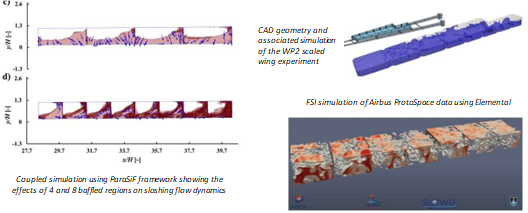
Related references:
Longshaw S. M. et al., A Coupled FSI Framework Using the Multiscale Universal Interface, IFASD, June 2022.
Liu, W. et al., A High-performance Open-source Solution for Multiphase Fluid-Structure Interaction, Int. J. Offshore Polar Eng., 32:1–7, 2022. DOI: 10.17736/ijope.2022.jc844
WP6: ROM and Analytical Models
Fuel Sloshing Reduced-Order Models (ROM)
Methods Developed
Methods have been developed for the identification of linear and nonlinear reduced-order models for sloshing.
Main findings:
- A non-linear, mass and momentum conservative CFD-based coarse mesh ROM has been developed, involving tuning to match input target loads through automated adjustment of liquid properties.
- Development of LFD approach for small perturbations of flexible sloshing tanks.
- Identification of bouncing ball equivalent mechanical models (UB and USRS) with parameters tuned on experimental data.
- Neural networks-based and surrogate sloshing models identified with experimental data collected by performing variable frequency and amplitude harmonic excitation tests or multiple steady harmonic tests with different frequencies and amplitudes.
Experimental Testing
WP6 is focused on the development, assessment and application of reduced-order models (ROMs) for fuel- sloshing/tank systems.
The sloshing ROMs being proposed offer varying degrees of physical accuracy, computational efficiency, and dynamic integration capabilities with other related disciplines such as structural dynamics and aeroelasticity.
Main objectives:
- Development of equivalent mechanical models (EMM) of sloshing fluid in partially filled fuel tanks using dynamically tuned spring-mass-damper systems.
- Use a computational fluid dynamics (CFD) approach to develop a ROM that incorporates a consistent pressure integration methodology in both 2D and 3D, ensuring the conservation of mass and momentum over a much smaller mesh than in traditional CFD schemes.
- Identification of a data-based ROM representing an input/output system relating the tank motion with the sloshing-induced force and moment on the walls. A linearized frequency domain (LFD) approach is proposed to describe the linear sloshing dynamics, together with a state-space representation.
- Use ROMs to perform integrated aeroelastic stability and response analyses to evaluate the load alleviation.
Achievements
The developed ROMs have proven to be successfully applied in the accurate reproduction of sloshing behavior in different applications.
Main findings:
- The pressure ROM is capable of computing tank wall pressures to engineering precision while being significantly faster to run as compared to detailed CFD for both simplified and industrial cases.
- LFD approach successfully applied to different tank shapes (e.g., a box tanks and a horizontal cylinder for which no frequency response functions are provided by analytical theory) for small perturbations.
- Bouncing ball models, NN-based ROMs and surrogate models provide good prediction of the sloshing-induced dissipation and displacement response in free response analyses.
- Integration of NN-based ROMs and surrogate model provided clear proof of load alleviation in gust responses analyses.
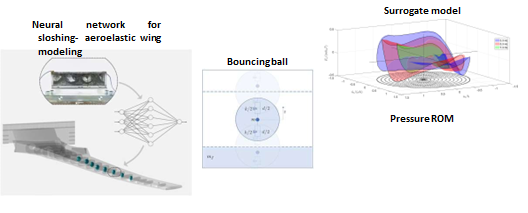
Related references:
L. Constantin, J. De Courcy, B. Titurus, T.C.S. Rendall, J.E. Cooper, "Analysis of damping from vertical sloshing in a SDOF system". Mechanical Systems and Signal Processing, 152, 107452, 2021. https://doi.org/10.1016/j.ymssp.2020.107452
F. Saltari, A. Traini, F. Gambioli, F. Mastroddi, "A linearized reduced-order model approach for sloshing to be used for aerospace design". Aerospace Science and Technology, 108, 106369, 2021. https://doi.org/10.1016/j.ast.2020.106369
M. Pizzoli, F. Saltari, G. Coppotelli, F. Mastroddi, "Neural network-based reduced-order modeling for nonlinear vertical sloshing with experimental validation". Nonlinear Dynamics 111, 8913-8933, 2023. https://doi.org/10.1007/s11071-023-08323-y
F. Saltari, M. Pizzoli, F. Gambioli, C. Jetzschmann, and F. Mastroddi. "Sloshing reduced-order model based on neural networks for aeroelastic analyses". Aerospace Science and Technology, 107708, 2022. https://doi.org/10.1016/j.ast.2022.107708
L. Constantin, J.J. De Courcy, B. Titurus, T.C.S. Rendall, J.E. Cooper, F. Gambioli, "Effect of Fuel Sloshing on the Damping of a Scaled Wing Model - Experimental Testing and Numerical Simulations". Applied Sciences, 12, 7860, 2022. https://doi.org/10.3390/app12157860
WP7: Integration into Design Framework
Software Integration: Streamlining Success
Methods Developed
Main findings:
Definition of the global structure of the software
A global layout structure of the software is proposed and discussed ensuring that the different software components are able to communicate in a proper way.
Definition of the program interfaces towards the different program components
In a second step the different blocks are detailed setting up the communication structure between the different program components. Based on these structures details concerning the program interfaces are elaborated.
Definition of the input / output format for the program
The input and output format is being elaborated.
Setting up of the program block structure
The global layer of the program is being set up. First simplified dummy components were programmed which was later on replaced by the dedicated software programs, i.e. the CFD and the structural programs as well as a dummy controller. The setting up of this part was supported by University of Cusano in Italy supporting the programming of software parts.
Experimental Testing
Main objectives:
In WP7 attention is put towards the consolidation of the different software elements in the frame of a software program. The software program is put into a state allowing proper initialization of the software as well as a proper post evaluation of the results. The code is optimized towards the needs of Airbus. It was therefore the first step to define the global structure together with Airbus.
Achievements
The software provides the entire structure of the project. It manages the file structure and provides a way for the user to change the configuration data.
The main functions are:
- Overall system coordination mastering configuration options
- Communication with other work packages to provide system simulation
- Simulation restart
- Plotting of the results
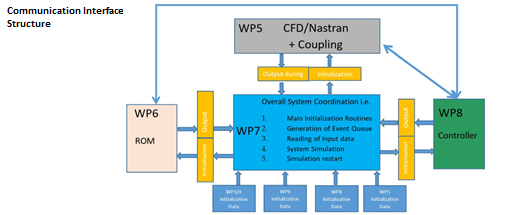
 This project has received funding from the European Union's Horizon 2020 research and innovation programme under grant agreement No 815044
This project has received funding from the European Union's Horizon 2020 research and innovation programme under grant agreement No 815044